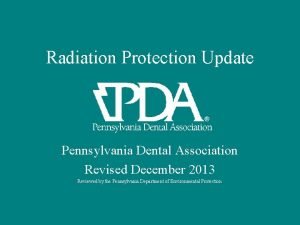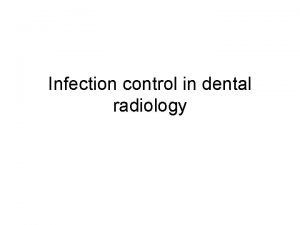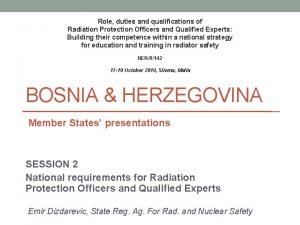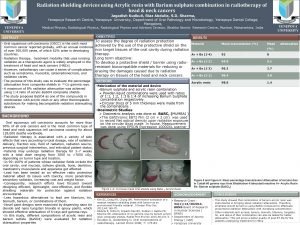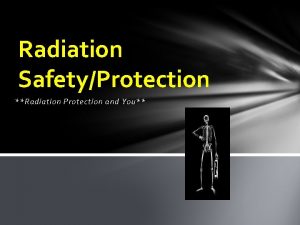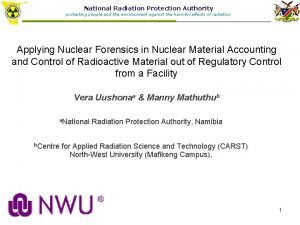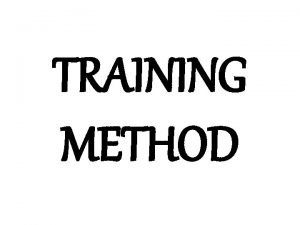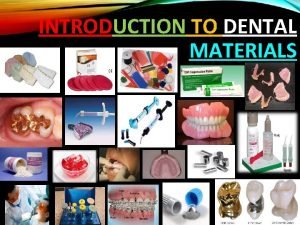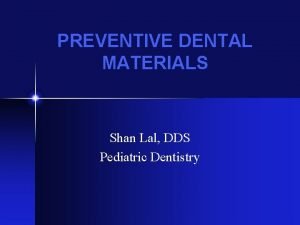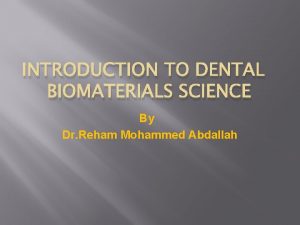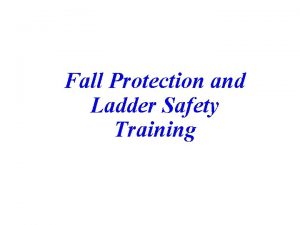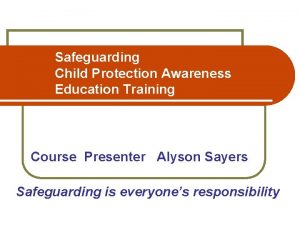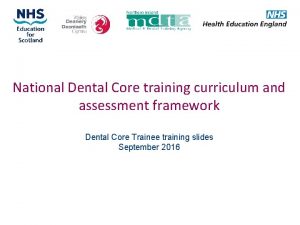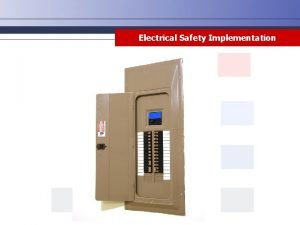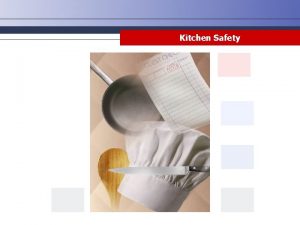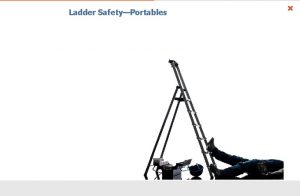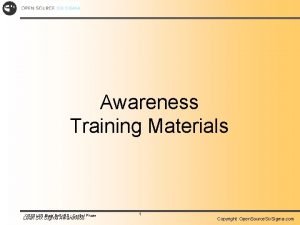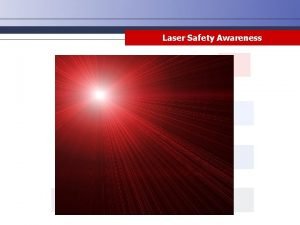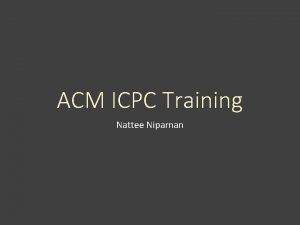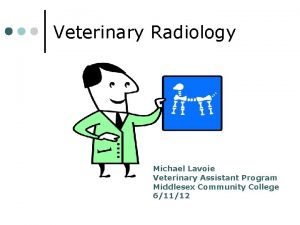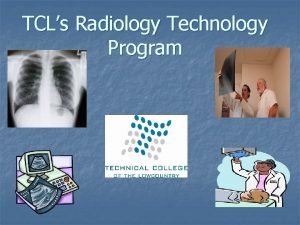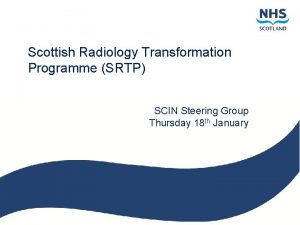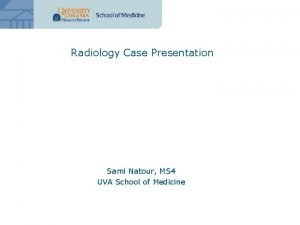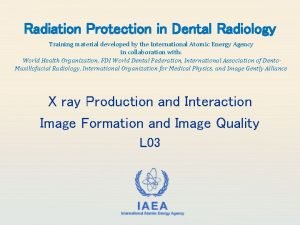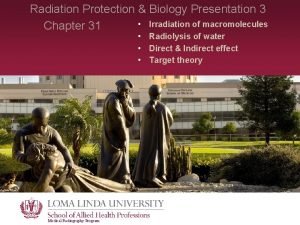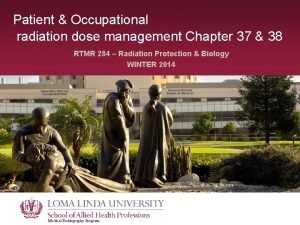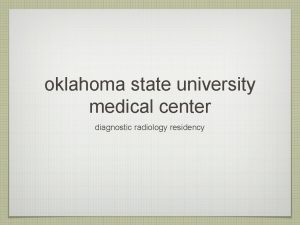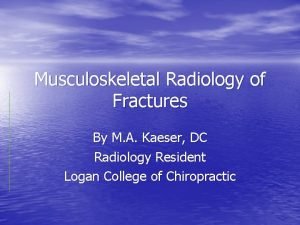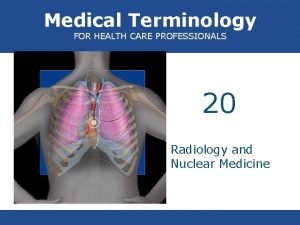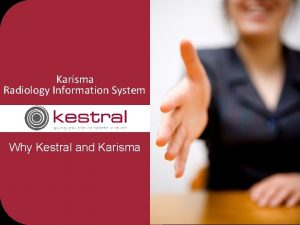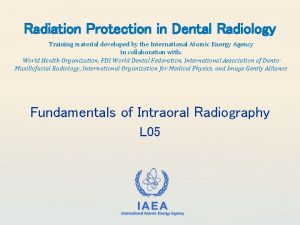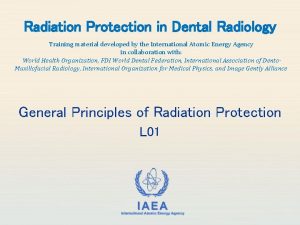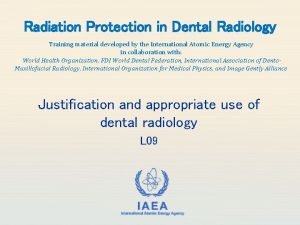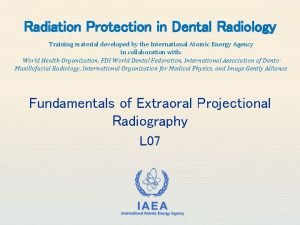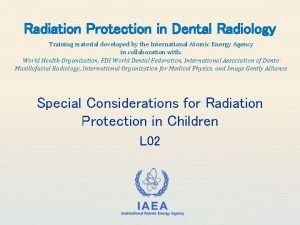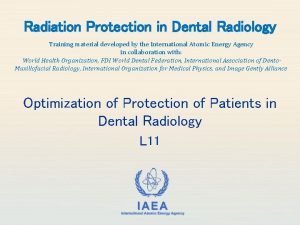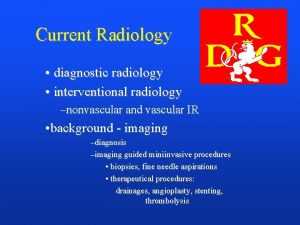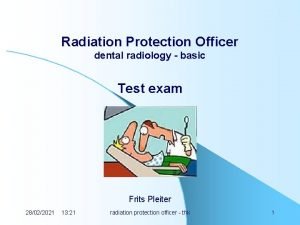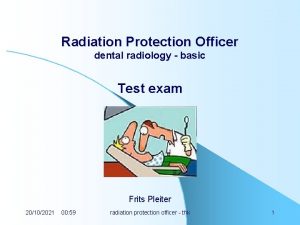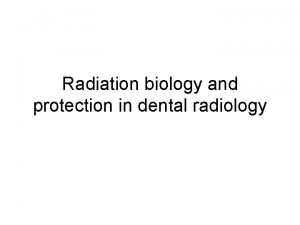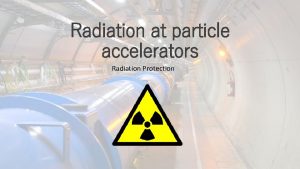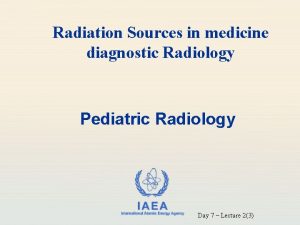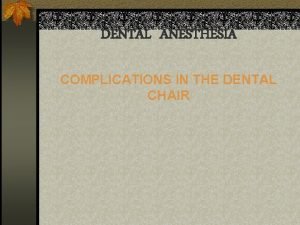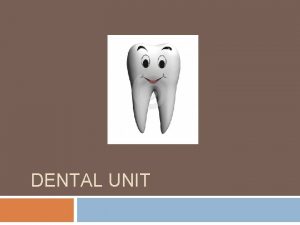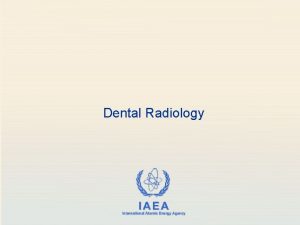Radiation Protection in Dental Radiology Training material developed




















































- Slides: 52

Radiation Protection in Dental Radiology Training material developed by the International Atomic Energy Agency in collaboration with: World Health Organization, FDI World Dental Federation, International Association of Dento. Maxillofacial Radiology, International Organization for Medical Physics, and Image Gently Alliance Quality Assurance in Dental Radiology L 10 IAEA International Atomic Energy Agency

Educational Objectives • Understand the general aspects of QA in radiology, and particular QA and QC aspects in dental radiology • Able to perform QC tests for different dental radiographic equipment (if responsible for such task) IAEA Radiation Protection in Dental Radiology L 10 Quality Assurance in Dental Radiology 2

Overview • • General principles of QA and QC QC test protocols per modality Dosimetry and dose monitoring Clinical image quality assessment IAEA Radiation Protection in Dental Radiology L 10 Quality Assurance in Dental Radiology 3

Overview • • General principles of QA and QC QC test protocols per modality Dosimetry and dose monitoring Clinical image quality assessment IAEA Radiation Protection in Dental Radiology L 10 Quality Assurance in Dental Radiology 4

Quality Assurance (QA) in radiology “as an organized effort by the staff operating a facility to ensure that the diagnostic images produced are of sufficiently high quality so that they consistently provide adequate diagnostic information at the lowest possible cost and with the least possible exposure of the patient to radiation” World Health Organization (WHO), 1982 IAEA Radiation Protection in Dental Radiology L 10 Quality Assurance in Dental Radiology 5

Quality Assurance (QA) in radiology International Basic Safety Standards (BSS), 2014 • “Registrants and licensees shall establish a comprehensive Quality Assurance program for medical exposures with the participation of appropriate qualified experts in radiophysics taking into account the principles established by the WHO. ” IAEA

Elements of a QA program • Acceptance and commission of a radiographic device • Periodic testing (and maintenance) of performance QC throughout its lifespan • Determination and follow-up of imaging protocols • Estimation of radiation dose to patients, workers and public • Training of workers • Adherence to policies and procedures IAEA Radiation Protection in Dental Radiology L 10 Quality Assurance in Dental Radiology 7

Quality control (QC) • Deals with performance of the equipment after installation • Regular timetable • Acceptance testing • Commissioning testing • Routine (periodic) testing • Usually involves a medical physicist IAEA Radiation Protection in Dental Radiology L 10 Quality Assurance in Dental Radiology 8

Acceptance & commissioning tests • Performed at installation of the equipment • Acceptance testing: a check of performance before clinical use, using pass/fail acceptability criteria (cfr. national/international standards) • Commissioning testing: provides baseline values for image quality and radiation dose • Compared with future periodic tests IAEA Radiation Protection in Dental Radiology L 10 Quality Assurance in Dental Radiology 9

Routine QC tests • Different timetables (daily, monthly, annually) can be used depending on the nature of the test • Safety system tests (e. g. emergency stop) • X ray tube performance (e. g. nominal k. V) • Image quality tests (e. g. resolution, artefacts) • Display performance • Dosimetry IAEA Radiation Protection in Dental Radiology L 10 Quality Assurance in Dental Radiology 10

Overview • • General principles of QA and QC QC test protocols per modality Dosimetry and dose monitoring Clinical image quality assessment IAEA Radiation Protection in Dental Radiology L 10 Quality Assurance in Dental Radiology 11

Routine QC tests: safety system tests • Emergency stop button available & in working order • Or: release of exposure button serves as stop • Audible signal / warning light during exposure • Mechanical obstruction • e. g. CBCT detector hitting patient: automatic stop? IAEA Radiation Protection in Dental Radiology L 10 Quality Assurance in Dental Radiology 12

Specific QC test protocols • The following sections will provide an overview of specific QC test protocols used in dental radiology for intra-oral, extra-oral and CBCT equipment • These protocols were based on (a combination) of existing guidelines, and discrepancies may exist regarding the tests, periodicity, acceptability criteria, etc. • Please refer to any relevant guidelines for your country/region when developing a QC protocol, ensuring that it fits with conventions and regulations (e. g. IEC standards when available, such as 61224 -3 -4) IAEA Radiation Protection in Dental Radiology L 10 Quality Assurance in Dental Radiology 13

QC test protocols: intra-oral • A series of test are recommended for intra-oral radiography, encompassing the X ray tube (incl. patient and scattered dose), film QC, digital receptor QC, and image display • More details, acceptability criteria, action levels, practical procedures: see AAPM 175 publication (AAPM, 2016) or similar documents applicable to your country/region IAEA Radiation Protection in Dental Radiology L 10 Quality Assurance in Dental Radiology 14

QC test protocols: intra-oral • Stability of the X ray tube head after it is released by the operator • Visual inspection of the tube housing • Leakage radiation should be measured is damage to the tube’s shielding is suspected • X ray field size (i. e. collimation) and source-skin distance should be in accordance with regulations and relevant recommendations IAEA Radiation Protection in Dental Radiology L 10 Quality Assurance in Dental Radiology 15

QC test protocols: intra-oral • Test of X ray tube output: • Beam quality: half-value layer • Kilovoltage and exposure time, compared with nominal values • See next slides for example • Reproducibility of exposure • Linearity of m. A and/or m. As IAEA Radiation Protection in Dental Radiology L 10 Quality Assurance in Dental Radiology 16

Routine QC tests: X ray tube • Accuracy of tube voltage (k. V) AC Pre-heating period (excluded from analysis) DC H. Bosmans IAEA Radiation Protection in Dental Radiology L 10 Quality Assurance in Dental Radiology 17

Routine QC tests: X ray tube • Accuracy of exposure time H. Bosmans IAEA Radiation Protection in Dental Radiology L 10 Quality Assurance in Dental Radiology 18

QC test protocols: intra-oral • When films are used: • QC of darkroom and/or film processors • To avoid film fogging due to exposure to light • QC of film processing (see also L 04/L 05) IAEA Radiation Protection in Dental Radiology L 10 Quality Assurance in Dental Radiology 19

QC test protocols: intra-oral • When digital image receptors are used: • Evaluation of uniformity, spatial resolution, contrast resolution • Not only periodic, but also when damage is suspected (e. g. due to dropping the sensor) • Evaluation of display performance (AAPM 2005, EFOMP 2015) IAEA Radiation Protection in Dental Radiology L 10 Quality Assurance in Dental Radiology 20

Routine QC tests: display performance • Luminance meters, test patterns AAPM TG 18 -QC multipurpose test pattern for evaluation of display monitors IAEA Radiation Protection in Dental Radiology L 10 Quality Assurance in Dental Radiology 21

QC test protocols: intra-oral • Entrance surface dose • Compare with local or international Diagnostic Reference Levels (see L 11) and achievable doses • Scattered radiation IAEA Radiation Protection in Dental Radiology L 10 Quality Assurance in Dental Radiology 22

Specific QC tools for dental radiography • Intraoral radiography • Step wedge (different thicknesses, typically of aluminium) • Find exposure at which a certain darkening is found (which is predefined, e. g. corresponding to the required exposure for a maxillary molar) IAEA H. Bosmans Radiation Protection in Dental Radiology L 10 Quality Assurance in Dental Radiology 23

Specific QC tools for dental radiography • Intraoral radiography • Line pair pattern (spatial resolution) • Contrast-detail pattern IAEA Radiation Protection in Dental Radiology H. Bosmans L 10 Quality Assurance in Dental Radiology 24

QC test protocols: extra-oral • General tests (tube leakage, k. V, reproducibility, film QC, digital QC) for extra-oral radiography (incl. panoramic radiography) are the same as for intra-oral radiography • But: different specifications or requirements may apply • Beam quality: minimum HVL value • Dose: measurement methodology, DRL value IAEA Radiation Protection in Dental Radiology L 10 Quality Assurance in Dental Radiology 25

QC test protocols: extra-oral • Specific test for panoramic radiography and ‘scanningbased’ cephalometric radiography: vertical/horizontal dimensions of X ray beam • Should coincide with slit at image receptor • Panoramic radiography: check alignment (image quality highly sensitive to proper patient alignment) • Broad-beam cephalometric radiography: field size should be compared with nominal values & light field IAEA Radiation Protection in Dental Radiology L 10 Quality Assurance in Dental Radiology 26

Specific QC tools for dental radiography • Panoramic radiography • Uniformity • • Add filtration to tube, make ‘blank’ exposure Central area will be darker (compensation for cervical spine) (note: the horizontal lines in the image below are the result of suboptimal detector calibration) H. Bosmans IAEA Radiation Protection in Dental Radiology L 10 Quality Assurance in Dental Radiology 27

Specific QC tools for dental radiography • Panoramic radiography • Alignment • • Position test object as a patient Evaluate image (circular dots: good alignment, elliptical dots: poor alignment) H. Bosmans IAEA Radiation Protection in Dental Radiology L 10 Quality Assurance in Dental Radiology 28

Image quality tools for dental radiography • Panoramic radiography • Beam size • • Width (at secondary collimation, detector side) and height Radiochromic film attached to X ray tube H. Bosmans IAEA Radiation Protection in Dental Radiology L 10 Quality Assurance in Dental Radiology 29

QC test protocols: CBCT • Several available guidelines regarding QC procedures CBCT • European Commission, Radiation Protection 172 (SEDENTEXCT guidelines) (EC, 2012) • UK Health Protection Agency (HPA, 2010) • German DIN 6868 -161 / DIN 6868 -15 • Unified protocol for CBCT (not exclusive for dental) (EFOMPESTRO-IAEA, 2017) • AAPM task group 261 (upcoming) IAEA Radiation Protection in Dental Radiology L 10 Quality Assurance in Dental Radiology 30

QC test protocols: CBCT • Standard tests: cfr. manufacturer’s specifications, recent guidelines, national regulations • X ray tube potential, tube leakage, total filtration or HVL, repeatability/reproducibility, beam collimation, slice thickness, display performance, visual inspection of image artefacts, dose to operator IAEA Radiation Protection in Dental Radiology L 10 Quality Assurance in Dental Radiology 31

QC test protocols: CBCT • Specific image quality tests • Uniformity: stability of grey values • • Conventionally: compare grey value for different regions in the FOV for a homogeneous object (intra-scan uniformity) In CBCT, if grey values are to be used as HU (see further), grey values for scans with central/peripheral test object position should be assessed as well (inter-scan uniformity) Pauwels et al. (2015), under the British Institute of Radiology's License to Publish IAEA Radiation Protection in Dental Radiology L 10 Quality Assurance in Dental Radiology 32

QC test protocols: CBCT • Specific image quality tests • Geometrical accuracy: check on raw data (mechanical movement of equipment and reconstructed image (linear/angular measurements) R. Pauwels IAEA Radiation Protection in Dental Radiology L 10 Quality Assurance in Dental Radiology 33

QC test protocols: CBCT • Specific image quality tests • • Grey value (GV) stability: reproducibility of grey values for a number of materials over time Hounsfield unit (HU) accuracy (only for machines which claim to yield HU): compare GV for different materials with corresponding nominal HU, check stability under varying exposure geometries (FOV, position of test object) R. Pauwels IAEA Radiation Protection in Dental Radiology L 10 Quality Assurance in Dental Radiology 34

QC test protocols: CBCT • Specific image quality tests • Noise: standard deviation of grey values in a homogeneous (section of a) test object • Can be combined with contrast (contrast-to-noise ratio, CNR) and/or measured using the same region of interest as that used for uniformity R. Pauwels IAEA Radiation Protection in Dental Radiology L 10 Quality Assurance in Dental Radiology 35

QC test protocols: CBCT • Specific image quality tests • Contrast resolution: contrast-to-noise ratio and/or visual / computer assisted evaluation of contrast-detail R. Pauwels IAEA Radiation Protection in Dental Radiology L 10 Quality Assurance in Dental Radiology 36

QC test protocols: CBCT • Specific image quality tests • Spatial resolution • Modulation transfer function (MTF) • • Evaluates decrease in contrast at increasing resolution Limit for visual perception at ~10% MTF R. Pauwels IAEA Radiation Protection in Dental Radiology L 10 Quality Assurance in Dental Radiology 37

Image quality tools for dental radiography • CBCT: combined phantoms • SEDENTEXCT IQ phantom • DIN phantom (different models) • … SEDENTEXCT IQ IAEA Example of DIN 6868 -161 phantom Radiation Protection in Dental Radiology L 10 Quality Assurance in Dental Radiology 38

QC test protocols: CBCT • Specific image quality tests • Spatial resolution • Point / line / edge spread function (are related to MTF) R. Pauwels IAEA Radiation Protection in Dental Radiology L 10 Quality Assurance in Dental Radiology 39

Overview • • General principles of QA and QC QC test protocols per modality Dosimetry and dose monitoring Clinical image quality assessment IAEA Radiation Protection in Dental Radiology L 10 Quality Assurance in Dental Radiology 40

Routine QC tests: dosimetry • Estimation of patient dose (‘average’ patient) • Using test objects (phantoms) • Different metrics used for different modalities • ESD, DAP/KAP, CTDI, DLP, … • See L 12 for more information on worker dose & protection • Complemented by dose monitoring (see further) IAEA Radiation Protection in Dental Radiology L 10 Quality Assurance in Dental Radiology 41

Routine QC tests: dosimetry • Intra-oral radiography: entrance skin dose (cfr. local legislation) • Panoramic/cephalometric radiography: dose-area product (DAP) • CBCT: DAP most commonly used IAEA Radiation Protection in Dental Radiology L 10 Quality Assurance in Dental Radiology 42

Patient dose monitoring • During clinical use • Typically relies on display of dose estimates by the equipment (not direct measurement) • Straightforward collection for groups of patients • Accuracy of dose estimates should be verified • Allows for the determination of (and comparison with) diagnostic reference levels (DRLs; see L 11) IAEA Radiation Protection in Dental Radiology L 10 Quality Assurance in Dental Radiology 43

Overview • • General principles of QA and QC QC test protocols per modality Dosimetry and dose monitoring Clinical image quality assessment IAEA Radiation Protection in Dental Radiology L 10 Quality Assurance in Dental Radiology 44

Clinical image quality assessment • Difficult to relate technical parameters (MTF, CNR) to clinical acceptability • Variations of technical parameters over time can indicate an issue, but imaging performance should be verified based on clinical image quality Which is (not) acceptable? Pauwels et al. (2014 b), under the British Institute of Radiology's License to Publish IAEA Radiation Protection in Dental Radiology L 10 Quality Assurance in Dental Radiology 45

Clinical image quality assessment • Reference image (of excellent or adequate quality, with the latter being more suitable in terms of optimization) • Provided by manufacturer or acquired during acceptance testing (skull phantom) R. Pauwels IAEA Radiation Protection in Dental Radiology L 10 Quality Assurance in Dental Radiology 46

Clinical image quality assessment • Reject analysis • Frequency of rejects for all images acquired during a certain period • Possible cause (e. g. operator error, patient movement, excessive artefacts, over- or underexposure) recorded • Target (e. g. 5%) can be set • Corrective actions (e. g. removal of metal objects in CT, improved positioning procedures, revision of exposure protocols) • Quality analysis on a sample of clinical images (standardized visual grading using dedicated image quality criteria) IAEA Radiation Protection in Dental Radiology L 10 Quality Assurance in Dental Radiology 47

Possible reasons for rejection • Under/overexposure: could be due to inconsistent tube output or improper selection of exposure settings • Poor contrast in intra-oral radiography: k. V as likely cause H. Bosmans IAEA Radiation Protection in Dental Radiology L 10 Quality Assurance in Dental Radiology 48

Possible reasons for rejection • Excessive noise: could be due to inconsistent tube output or improper selection of exposure settings R. Pauwels IAEA Radiation Protection in Dental Radiology L 10 Quality Assurance in Dental Radiology 49

Possible reasons for rejection • Artefacts: may require detector recalibration, evaluation of film processing, … Exposure to visible light Stains due to developer Bleaching (overexposure to fixator) H. Bosmans IAEA Radiation Protection in Dental Radiology L 10 Quality Assurance in Dental Radiology 50

References AAPM (2016) Report No. 175 - Acceptance Testing and Quality Control of Dental Imaging Equipment. http: //www. aapm. org/pubs/reports/RPT_175. pdf AAPM (2005) Online Report No. 03, Assessment of Display Performance for Medical Imaging Systems. http: //aapm. org/pubs/reports/OR_03. pdf EFOMP( 2015) Quality controls in digital mammography – Protocol of the EFOMP mammo working group. http: //www. efomp. org/index. php/scientific-guidance-and-protocols/351 mammo-protocol European Commission (2012) Radiation Protection No 172: Cone beam CT for dental and maxillofacial radiology. Evidence based guidelines. Luxembourg: Office for Official Publications of the European Communities. HPA, Health Protection Agency (2010) Recommendations for the design of X-ray facilities and quality assurance of dental Cone Beam CT (Computed tomography) systems. IAEA Radiation Protection in Dental Radiology L 10 Quality Assurance in Dental Radiology 51

References (cont. ) Deutsches Institut für Normung (2013) DIN 6868 -161: Image quality assurance in X-ray departments - Part 161: RöV acceptance testing of dental radiographic equipment for digital cone beam computed tomography. Berlin: Deutsches Institut für Normung. Original and English translation available at https: //www. beuth. de/en/standard/din 6868 -161/164214522. Deutsches Institut für Normung (2015) DIN 6868 -15: Image quality assurance in X-ray departments - Part 15: RöV constancy testing of X-ray installations for dental radiographic equipment for digital cone-beam computed tomography. Berlin: Deutsches Institut für Normung [in German]. Pauwels R et al. (2014) A pragmatic approach to determine the optimal k. Vp in cone beam CT: balancing contrast-to-noise ratio and radiation dose. Dentomaxillofac Radiol. 43(5): 20140059. Pauwels R et al (2015) CBCT-based bone quality assessment: are Hounsfield units applicable? Dentomaxillofac Radiol. 44(1): 20140238. doi: 10. 1259/dmfr. 20140238. WHO (1982) Quality assurance of health services : concepts and methodology IAEA Radiation Protection in Dental Radiology L 10 Quality Assurance in Dental Radiology 52
 Pa dental radiology ce requirements
Pa dental radiology ce requirements History of dental radiology ppt
History of dental radiology ppt Darkroom infection control guidelines
Darkroom infection control guidelines Radiation protection officer qualifications
Radiation protection officer qualifications Barium sulphate board for radiation protection
Barium sulphate board for radiation protection Cardinal principles of radiation protection
Cardinal principles of radiation protection National radiation protection authority namibia
National radiation protection authority namibia Circuit training method was developed by
Circuit training method was developed by Ideal dental material
Ideal dental material Preventive dental materials
Preventive dental materials Marginal percolation
Marginal percolation Auxiliary dental materials examples
Auxiliary dental materials examples Scaffold ppt
Scaffold ppt Ladder outline
Ladder outline Child protection training materials
Child protection training materials Child protection awareness training
Child protection awareness training Gd and t symbols
Gd and t symbols Standard costing and variance analysis formulas
Standard costing and variance analysis formulas Cultural relativism meaning
Cultural relativism meaning Refers to the knowledge language values customs
Refers to the knowledge language values customs Material and non material culture examples
Material and non material culture examples Example of useful materials
Example of useful materials Dental core training
Dental core training Bullying and harassment training presentation
Bullying and harassment training presentation Disclaimer for training material
Disclaimer for training material Disclaimer for training material
Disclaimer for training material Disclaimer for training material
Disclaimer for training material Corporate training materials
Corporate training materials Training material development
Training material development Ladder ratings
Ladder ratings Open source six sigma training material
Open source six sigma training material Disclaimer for training material
Disclaimer for training material Counterfeit material awareness training
Counterfeit material awareness training Gmp training topics
Gmp training topics Icpc training material
Icpc training material Middlesex radiology
Middlesex radiology Pharmacology and venipuncture
Pharmacology and venipuncture Radiology st1 competition ratio
Radiology st1 competition ratio Positive galeazzi sign
Positive galeazzi sign Tcl bookstore
Tcl bookstore Elsevier statdx
Elsevier statdx Srtp radiology
Srtp radiology Uva radiology tutorial
Uva radiology tutorial Hlc accreditation
Hlc accreditation Grid conversion factor
Grid conversion factor Compton scatter radiology
Compton scatter radiology Main chain scission radiology
Main chain scission radiology Radiology terminology
Radiology terminology Dose limits radiology
Dose limits radiology Oklahoma state radiology residency
Oklahoma state radiology residency Greenstick fracture fibula
Greenstick fracture fibula Medical terminology for radiology
Medical terminology for radiology Karisma radiology
Karisma radiology
